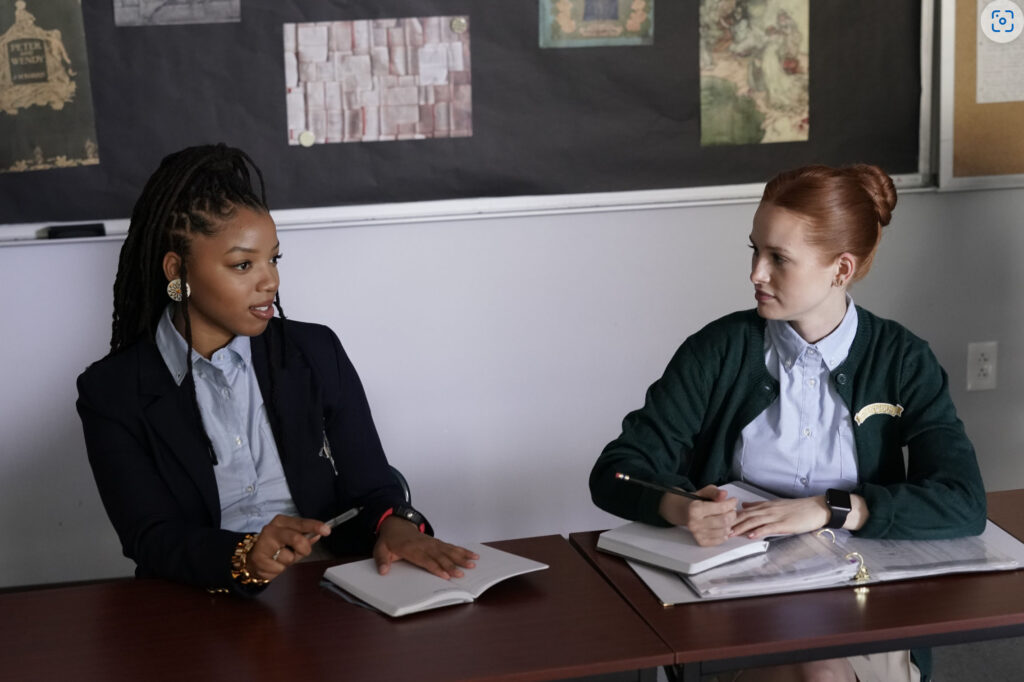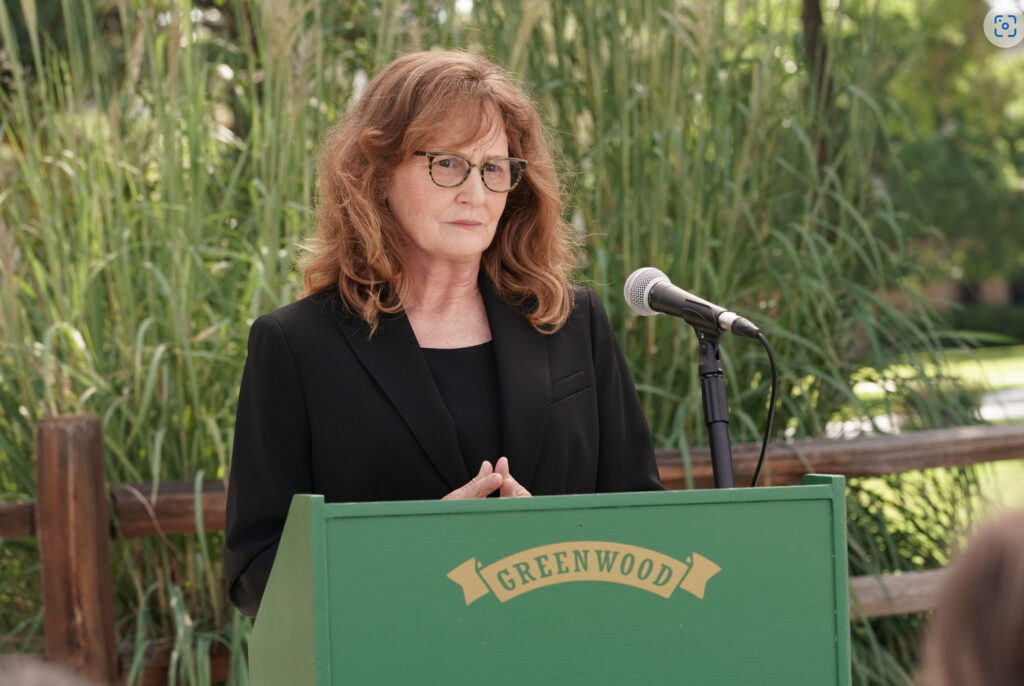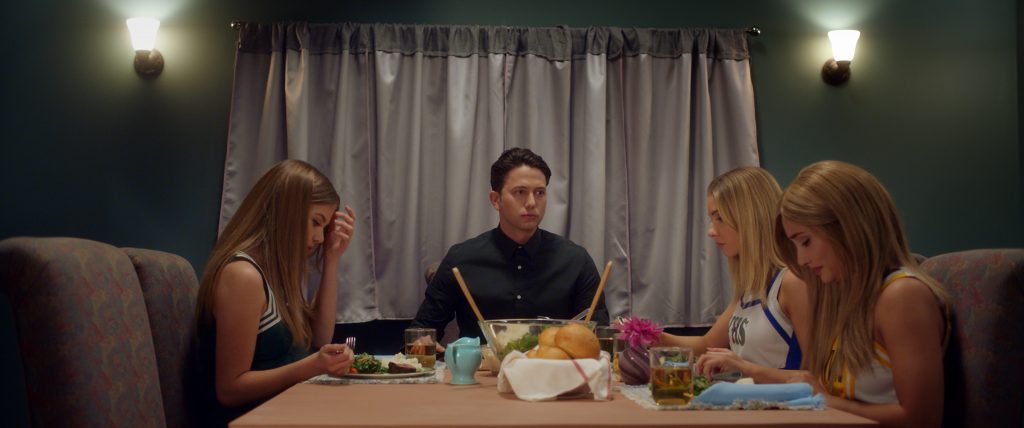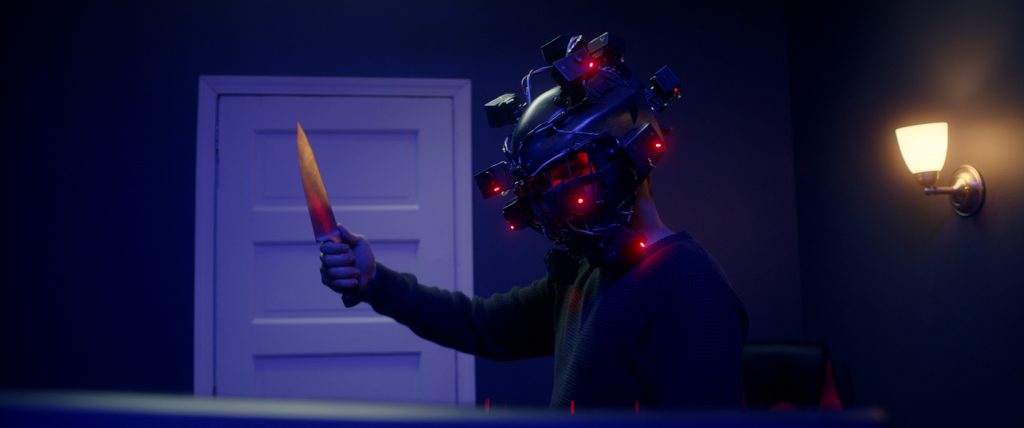September 2, 2022
by Carla Hay

Directed by Sabrina Jaglom
Culture Representation: Taking place in Los Angeles, the dramatic film “Jane” features a predominantly white cast of characters (with a few African Americans, Asians and Latin people) representing the working-class and middle-class.
Culture Clash: After her best friend commits suicide, a teenager in her last year of high school sees visions of her dead friend, who seems to inspire her to commit various crimes.
Culture Audience: “Jane” will appeal mainly to people who are interested in watching mediocre and predictable movies about teenage girls who are catty and obsessive.

Heinously using suicide as a story gimmick, “Jane” is the type of formulaic teenage drama movie that looks it could have been made as disposable Netflix content. Too many plot holes and unanswered questions ruin any credibility that “Jane” tries to have. It’s yet another movie about havoc wreaked by a selfish, immoral teen who will stop at nothing to get what she wants. Expect to see “mean girl” scenes repeated to monotony in “Jane.”
“Jane” is the feature-film debut of writer/director Sabrina Jaglom (who co-wrote the “Jane” screenplay with Rishi Rajani), and it’s the second movie released by the Creator+ movie distribution company and streaming service. Creator+’s first movie is the romantic comedy “Diamond in the Rough,” released in June 2022. Based on these tepid movie offerings, Creator+ needs to come up with much better content that would be worth the price of a movie ticket. Everything about “Jane” looks like a made-for-TV movie.
“Jane” begins with the suicide of the movie’s title character. Jane (played by Chloe Yu), who is 17 or 18 years old, is seen jumping off of a plank overlooking a cliff. Jane attended a private high school in Los Angeles named Greenwood School for Girls, where the students are required to wear matching uniforms. It’s an elite prep school where students come from middle-class and upper-middle-class families. (“Jane” was actually filmed in New Mexico.)
Jane’s two closest friends at school—classmates Olivia Brooks (played by Madelaine Petsch) and Isabelle “Izzy” Morris (played by Chloe Bailey)—are devastated by Jane’s death, which happened at the beginning of the school year. Olivia and Izzy are both in their last year at Greenwood, and they both have high hopes to get into Stanford University, which is their first-choice university. During the course of the movie, Olivia and Izzy inflict mean-spirited bullying on people at their school, but Olivia is much more obsessive and more vindictive than Izzy is.
Olivia also has some serious mental health issues. Sometimes, when Olivia is overwhelmed with negative emotions, she faints. Throughout the movie, Olivia sees visions of Jane (who never says a word in the visions), usually right before Olivia does something cruel or illegal. Sometimes, Jane is seen silently encouraging Olivia to do something wrong, or Jane is seen doing something wrong, when in reality, Olivia is the one committing these acts.
You don’t have to be a psychiatrist to know that it’s Olivia’s way of projecting the worst parts of herself into her memory of Jane, in order for Olivia to psychologically disassociate herself from her own misdeeds. Olivia doesn’t come right out and say, “Jane made me do it,” because she never tells people that she sees Jane. (This isn’t a ghost horror story.) Instead, throughout the movie, Olivia pretends to be ignorant about certain things that Jane is seen on screen doing, but Olivia doesn’t want to admit that Olivia actually did these things.
Because the movie “Jane” is so transparent about this psychological duplicity, there’s no real suspense if you’ve seen these types of “bad girl with an alter ego” movies many times already. You already know that whatever nasty games Olivia is going to play, they’re going to escalate and get worse. And someone might end up physically hurt or dead. The only real curiosity might come from wondering how much Olivia will get away with and what will happen if anyone finds out her secrets.
“Jane” makes it looks like the mental unraveling of Olivia is triggered or aggravated because of Jane’s suicide and Olivia’s obsession to get into Stanford. However, it’s also suggested that Olivia’s mental health problems have existed long before her last year of high school, but Olivia has been able to hide these problems very well. When Olivia finds out that her application to Stanford has been deferred, she predictably has a minor meltdown about it. A sympathetic school counselor named Mrs. Billings (played by Ramona DuBarry) offers to work with Olivia to craft an appeal letter to Stanford’s admissions department.
Olivia is the captain of the school’s debate team, where she is accustomed to being the “queen bee.” But the arrival of a new transfer student named Camille Cortez (played by Nina Bloomgarden) threatens Olivia because Camille has experience as a school debater who went to a national competition. Greenwood’s debate team has only made it as far as a state competition. Camille gloats about this fact when talking to Olivia for the first time.
The teacher in charge of Greenwood’s debate team is an easygoing instructor named Mr. Richardson (played by Ian Owens), who wants Camille to possibly co-lead the debate team with Olivia. Not surprisingly, Olivia hates the idea and doesn’t want it to happen. Camille and Olivia predictably have a clash of egos, and they exchange thinly veiled insults at each other in their first conversation together in the debate classroom.
Camille tells Olivia, “I just think this team can really benefit from my leadership.” This comment sets Olivia over the edge. In full view of Mr. Richardson and other students, Olivia yells at Camille, “Fuck you!” And then Olivia faints. Even though Olivia later says she’s sorry for what happened, Mr. Richardson tells Olivia that she can’t participate in the team’s next debate, so that Olivia can take some time for self-care.
Olivia is very angry about this temporary suspension. And you know what that means: Olivia is going to find a way to get Camille out of the debate team. Olivia tells Izzy that Camille is a horrible person, in order to turn Izzy against Camille. Izzy and Olivia then find out that Camille left her previous school in New York because of a scandal where Camille accused a teacher of sexual misconduct. After an investigation by the school, the teacher was cleared of the accusation.
Olivia and Izzy don’t know the whole story, but Olivia comes up with the idea to create a fake online account to send unsettling messages to Camille about this scandal. They use a social media platform called Connect, which looks similar to Facebook. Olivia and Izzy’s plan is to make Camille so psychologically shaken, she won’t be able to concentrate, and she’ll fail on the debate team.
It just so happens that when Olivia and Izzy are hanging in Izzy’s bedroom, they find out that on Izzy’s laptop computer, Jane was using Connect and accidentally forgot to log out. Olivia and Izzy have the twisted idea to send the anonymous messages from Jane’s Connect account. Over time, their bullying from this account targets other people at the school.
One of the targets is a teacher named Mrs. West (played by Victoria Foyt), who gave Olivia a grade on an assignment that was below what Olivia wanted. Another person who becomes a victim of Olivia and Izzy’s wrath is a student named Josa (played by Kerri Medders), who begins dating a guy who broke up with Izzy. Olivia and Izzy’s revenge plot against Josa has much worse consequences than hurt feelings from anonymous social media messages.
Greenwood’s chief administrator Principal Rhodes (played by Melissa Leo) has a no-nonsense approach in interrogating the students at the school when the bullying gets out of control. But the movie’s biggest failing is that Olivia and Izzy are so obviously the prime suspects who would be the most likely to have access to the dead Jane’s Connect account. However, Olivia and Izzy don’t get the type of immediate scrutiny and suspicion from school authorities and other students that Olivia and Izzy would get if this were a story that happened in real life, not in a movie.
“Jane” also mishandles the issue of people’s Internet activities being easily traced by IP (Internet protocol) addresses if they don’t have a VPN service or another way of masking their IP address. Olivia and Izzy (who aren’t as smart as they think they are) don’t think about being exposed through IP address tracing until it’s too late, after they’ve already both logged on to Jane’s phantom account several times, using their own personal computer devices. This fear of being caught through their IP addresses becomes a subplot that eventually goes away in an implausible manner.
Another plot hole is in the investigation of something terrible that happened to Josa because of a deliberate action by Olivia and Izzy. In order for viewers to believe that Olivia and Izzy escaped suspicion, you’d have to believe that investigators wouldn’t think to ask Josa who could’ve possibly been responsible for the action that caused Josa serious harm. If investigators did ask Josa, she would most likely remember that the only two people who were with Josa right before this harmful incident were the same two people who gave something to Josa that caused this harmful incident. And those two people were Olivia and Izzy.
Olivia’s loving and supportive parents—Steve Brooks (played by Morse Bicknell) and Eleanor Brooks (played by Amie MacKenzie)—are oblivious to Olivia’s dark side and think she’s a good girl who’s grieving over the suicide of Jane. Olivia is an only child who has a lot of freedom to do what she wants when she’s home alone. Izzy’s parents or other family members are never shown in the movie. The movie’s big climatic scene is very problematic because it’s sloppily constructed and doesn’t take into account that DNA, fingerprints and cell phone tower records would place someone at the scene of a crime when that person claims not to have been there at all.
The cast members of “Jane” give adequate performances with their characters. Petsch (who is also one of the producers of “Jane”) has some chilling moments as the very emotionally disturbed Olivia. However, so much of “Jane” is a retread of “bad girls who pretend to be good” movies, there’s nothing in “Jane” that stands out as being completely original. “Jane” doesn’t sufficiently address all the mental health issues that the movie irresponsibly uses as plot devices. The ending of “Jane” might have been intended to be disturbing, but it really just looks like the filmmakers’ cheap and lazy way of leaving the possibility open that this forgettable movie could get a sequel.
Creator+ released “Jane” in select U.S. cinemas on August 26, 2022. The movie premieres on Creator+ on September 16, 2022.


